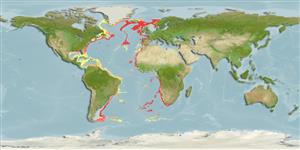Holocephali (quimeras) (chimaeras) >
Chimaeriformes (Chimaeras) >
Rhinochimaeridae (Longnose chimaeras)
Etymology: Rhinochimaera: A chimaera with rhinos (Gr.), nose, referring to long, pointed proboscis of R. pacifica. (See ETYFish); atlantica: ana- (L.), belonging to: North Atlantic Ocean, where it occurs. (See ETYFish).
Environment: milieu / climate zone / depth range / distribution range
Ecologia
marinhas batidemersal; intervalo de profundidade 200 - 1500 m (Ref. 117245), usually 400 - 1500 m (Ref. 4444). Deep-water; 67°N - 58°S, 98°W - 26°E
Northwest to Northeast Atlantic, and Southeast Atlantic: Antitropical. Eastern Atlantic: northern Bay of Biscay northward to Iceland, including the Iceland-Faroes Rise (Ref. 3183); off Cayar and Cape Barbas in Western Sahara, off Namibia and South Africa (Ref. 4444). Western Atlantic: off Nova Scotia, Canada and New England, USA (Ref. 3183).
Tamanho / Peso / Idade
Maturity: Lm ? range ? - ? cm
Max length : 140 cm TL macho/indeterminado; (Ref. 4444)
Espinhos dorsais (total) : 1; Espinhos anais: 0; Raios anais : 0. A longnose chimaera with a narrow, moderately flattened, pointed snout and smooth, sharp-edged tooth plates; pectoral fins narrow, and caudal fin with very short terminal filament and wide-spaced tubercles on upper edge (in adults and large juveniles) (Ref. 5578). Whitish to light brown in color (Ref. 5578).
Found on or near the bottom of continental slopes (Ref. 5578). Forms groups according to sex and size (Ref. 5578). Feeds on shrimps and crabs (Ref. 27637). Oviparous (Ref. 205). Eggs are encased in horny shells (Ref. 205).
Ciclo de vida ou comportamento de acasalamento
Maturities | Reprodução | Spawnings | Egg(s) | Fecundities | Larvas
Krefft, G., 1990. Rhinochimaeridae. p. 114-116. In J.C. Quero, J.C. Hureau, C. Karrer, A. Post and L. Saldanha (eds.) Check-list of the fishes of the eastern tropical Atlantic (CLOFETA). JNICT, Lisbon; SEI, Paris; and UNESCO, Paris. Vol. 1. (Ref. 4444)
Status na Lista Vermelha da UICN (Ref. 130435)
Ameaça para os humanos
Harmless
Uso pelos humanos
Pescarias: espécies comerciais
Ferramentas
Relatórios especiais
Baixar XML
Fontes da internet
Estimates based on models
Preferred temperature (Ref.
123201): 3.4 - 8.9, mean 6.7 °C (based on 174 cells).
Índice de diversidade filogenética (Ref.
82804): PD
50 = 0.6289 [Uniqueness, from 0.5 = low to 2.0 = high].
Bayesian length-weight: a=0.00195 (0.00083 - 0.00458), b=3.15 (2.95 - 3.35), in cm total length, based on LWR estimates for this (Sub)family-body shape (Ref.
93245).
Nível Trófico (Ref.
69278): 3.9 ±0.46 se; based on food items.
Resiliência (Ref.
120179): Baixo, tempo mínimo de duplicação da população 4,5 - 14 anos (Assuming Fec <100).
Fishing Vulnerability (Ref.
59153): Very high vulnerability (84 of 100).
Climate Vulnerability (Ref.
125649): Moderate vulnerability (38 of 100).
Nutrients (Ref.
124155): Calcium = 8.71 [2.52, 29.40] mg/100g; Iron = 0.36 [0.12, 0.92] mg/100g; Protein = 14.2 [9.9, 18.2] %; Omega3 = 0.262 [0.098, 0.711] g/100g; Selenium = 22.4 [6.6, 72.4] μg/100g; VitaminA = 5.02 [1.05, 22.07] μg/100g; Zinc = 0.293 [0.152, 0.567] mg/100g (wet weight);
